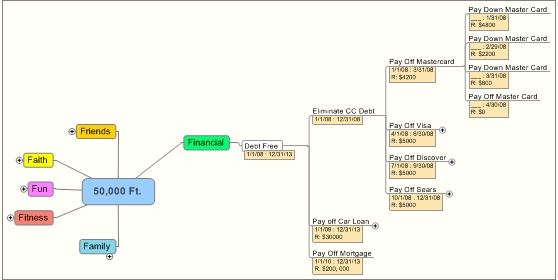DA Described 3 types of projects.
The majority just need a defined outcome and the next action
15% need some mind-mapping, brainstorming.
5% need massive 50k-20k outcome vision, planning evaluation.
For the first type. How would this work?
Project List
Project One Outcome -- NA for project one
Project two Outcome --- NA for project two
Then what happens after you complete THAT NA for project one? You just erase it and fill in the next one? Trying to figure out the best paper-based, phone based, or computer based system for keeping track my insanely endless array of projects.
Differentiating between those three categories will do wonders for me b/c I had projects like "improve financial success" (no doubt a type 2 or three project) mixed in with the type 1 projects of simplistic things like "add blog to site".
And then how do you decide which project to "do"?
I'm realizing GTD breeds OCD. It's just obsessive compulsive to have lists. I've seen people who gtded with google notebooks every frew days, hand drag over new actions from another notebook. Then the rewriting of lists...it's just psycho and breeds neurosis, I'm beginning to realize after gtding for months. Plus it feels like a cult, too. The @phone lists are great, and the 50k to runway idea is great, but most the rest is just, I fear, a breeding ground for ocd or just compulsive over-analysis. I wish there was a healthy balance between "out of mind" and "in a good system".
I also just haven't been motivated to do the projects on my project list mainly because they don't seem relevant. But everyone raves about "well a smarter part of my brain put them there!!" Well, so did an "older" more antiquated mental outlook. For that reason it can lock you into past habits, impeding necessary change. Maybe I need a better evaluation discard/keep system for projects. I love being organized. I thrive on that. Organization is just a massive form of clarity and freedom when done right, but I think the solution here is just eliminate crap from my life. 50k to 40k simplification.
The majority just need a defined outcome and the next action
15% need some mind-mapping, brainstorming.
5% need massive 50k-20k outcome vision, planning evaluation.
For the first type. How would this work?
Project List
Project One Outcome -- NA for project one
Project two Outcome --- NA for project two
Then what happens after you complete THAT NA for project one? You just erase it and fill in the next one? Trying to figure out the best paper-based, phone based, or computer based system for keeping track my insanely endless array of projects.
Differentiating between those three categories will do wonders for me b/c I had projects like "improve financial success" (no doubt a type 2 or three project) mixed in with the type 1 projects of simplistic things like "add blog to site".
And then how do you decide which project to "do"?
I'm realizing GTD breeds OCD. It's just obsessive compulsive to have lists. I've seen people who gtded with google notebooks every frew days, hand drag over new actions from another notebook. Then the rewriting of lists...it's just psycho and breeds neurosis, I'm beginning to realize after gtding for months. Plus it feels like a cult, too. The @phone lists are great, and the 50k to runway idea is great, but most the rest is just, I fear, a breeding ground for ocd or just compulsive over-analysis. I wish there was a healthy balance between "out of mind" and "in a good system".
I also just haven't been motivated to do the projects on my project list mainly because they don't seem relevant. But everyone raves about "well a smarter part of my brain put them there!!" Well, so did an "older" more antiquated mental outlook. For that reason it can lock you into past habits, impeding necessary change. Maybe I need a better evaluation discard/keep system for projects. I love being organized. I thrive on that. Organization is just a massive form of clarity and freedom when done right, but I think the solution here is just eliminate crap from my life. 50k to 40k simplification.

